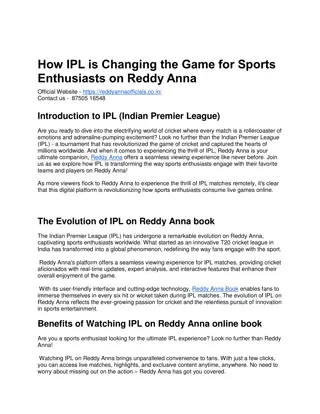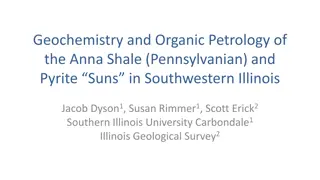
Composition-Based Combinatorial Test Design Method
"Explore a composition-based method for combinatorial test design in Unix shell commands, featuring examples of ls, grep, and their composition. Learn about the main contributions and the distinction between input and output in test plans. Discover how to formulate and solve a composition-oriented CTD problem efficiently."
Download Presentation

Please find below an Image/Link to download the presentation.
The content on the website is provided AS IS for your information and personal use only. It may not be sold, licensed, or shared on other websites without obtaining consent from the author. If you encounter any issues during the download, it is possible that the publisher has removed the file from their server.
You are allowed to download the files provided on this website for personal or commercial use, subject to the condition that they are used lawfully. All files are the property of their respective owners.
The content on the website is provided AS IS for your information and personal use only. It may not be sold, licensed, or shared on other websites without obtaining consent from the author.
E N D
Presentation Transcript
A Composition-Based Method for Combinatorial Test Design Eitan Farchi, IBM Research, Haifa Seri Khoury, Technion Amir Shwartz and Anna Zamansky, University of Haifa
Composition Model Model Module A Module B Test Plan Test Plan
Example: Unix Shell Commands ls ls - listing the contents of a directory Many optional parameters: -laxo lists files with permissions -l shows hidden files -a displays files in a line format
Example: Unix Shell Commands grep grep searching for lines containing a match to a given pattern. grep -w ctd myfile.txt search the file myfile.txt for lines containing ctd , selecting only those lines that form whole words
Example: Unix Shell Commands Consider now their composition Consider now their composition ls -l | grep -w ctd search the file names of the current directory for ctd
Example: Unix Shell Commands We have: - Models of ls and grep - Test plans for ls and grep Idea of Composition : Reuse resources created for the individual system calls for testing the sequential scenarios. How expensive is it?
Main contribution Formulate a composition-oriented CTD problem Propose an efficient algorithm to solve it
Making a distinction between input and output Test t: (a1, a2, a3, b1, b3) A B t: A B
Test Plan A test plan P: A B is a triple (E,R,T): E is the system model system model: a set of executable tests t: A B R is a set of coverage requirements coverage requirements T is the set of tests: tests: a subset of E P is complete complete if every coverage requirement is covered by some test t T.
Composition of models E2: B C E1: A B A B C B Open for Permission File File Result E1 E2: A C read user small small success write admin large large failure C A Open for Permission Result read user success write admin failure
Composition of tests T1: A B T2: B C (read, user, small) (small, success) open open- -for for permission file permission file file file status status T1 T2: (read, user, success)
Composition of tests T1: A B T2: B C (read, user, small) (large, success) o open pen- -for permission file for permission file file file status status T1 T2: not defined not defined
The problem Complete test plan P1 = (E1,R1,T1) Complete test plan P2 = (E2,R2,T2) P1 and P2 are not composable: T1 T2 may not be a complete test plan for E1 E2! Can we build Can we build c composable omposable test plans? test plans?
The CTD problem Given a system model E and a set of coverage requirements R, find a complete and sufficiently small complete and sufficiently small test plan P = (E, R, T). Greedy algorithm based on BDDs by Segall, Tzoref- Brill & Farchi (implemented in IBM Functional Coverage Unified Solution (FoCuS))
The Composition-Oriented CTD problem Given system models E1: A B and E2: B C and corresponding coverage requirements R1 and R2, find complete and sufficiently small complete and sufficiently small test plans for them which are also composable composable.
The algorithm An extension of the greedy algorithm based on BDDs by Segall, Tzoref- Brill & Farchi (implemented for FoCuS) Inputs: two system models and their corresponding coverage requirements Outputs: composable composable and complete complete test plans for these models and
Presented a formulation of a Presented a formulation of a version of CTD problem relevant version of CTD problem relevant when composition of different when composition of different systems components is to be systems components is to be tested. tested. Summary Presented a BDD Presented a BDD- -based algorithm for solving the new composition for solving the new composition- - oriented problem oriented problem based algorithm Preliminary Preliminary e evaluation shows that valuation shows that algorithm performs as well the algorithm performs as well the FoCuS BDD FoCuS BDD- -based CTD algorithm, based CTD algorithm, but we get composability for free but we get composability for free
Evaluation using Evaluation using large examples examples large- -size size How to systematicall increase How to systematicall increase reusability of CTD artifact? reusability of CTD artifact? Future Work What other operations other than What other operations other than composition are naturally defined composition are naturally defined on test plans? on test plans? Thank you for your attention! Thank you for your attention!






















